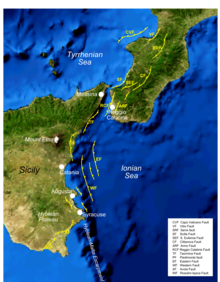1169 Sicily earthquake
Ms[3] | |
| Epicenter | 37°13′01″N 14°57′00″E / 37.217°N 14.95°E[2] |
|---|---|
| Areas affected | Eastern Sicily |
| Max. intensity | MMI X (Extreme) |
| Tsunami | Yes |
| Casualties | 15,000–25,000 deaths |
The 1169 Sicily earthquake occurred on 4 February 1169 at 08:00 local time on the eve of the feast of
Tectonic setting

Sicily lies on part of the complex convergent boundary where the African Plate is subducting beneath the Eurasian Plate. This subduction zone is responsible for the formation of the stratovolcano Mount Etna. Most of the damaging earthquakes occur on the Siculo-Calabrian rift zone, a zone of extensional faulting which runs for about 370 kilometres (230 mi), forming three main segments through Calabria, along the east coast of Sicily and immediately offshore, and finally forming the southeastern margin of the Hyblean Plateau, a carbonate platform in southeastern Sicily. Faults in the Calabrian segment were responsible for the 1783 Calabrian earthquakes sequence.[4]
In the southern part of the eastern coast of Sicily, investigations have identified a series of active
Earthquake
The location of the earthquake's epicentre is quite uncertain, with different seismologists giving locations offshore and onshore; there is similar uncertainty regarding the 1693 Sicily earthquake. The damaged area is similar to that for the 1693 earthquake, suggesting that both the location and magnitude were similar.[3] Intensities of X (Extreme) have been estimated for Catania, Lentini and Modica, IX (Violent) at Syracuse and Piazza Armerina and VIII (Severe) at Santi Pietro e Paolo and Messina. The earthquake was also felt in Calabria with a maximum intensity of VI (Strong) in Reggio Calabria.[2]
The magnitude of the earthquake has been estimated from intensity information and these estimates vary from 6.4 on the Me (Energy magnitude scale)
Tsunami
The tsunami affected most of the Ionian coast of Sicily and caused inundation from Messina in the north to the mouth of the Simeto River in the south.[6]
Tsunami deposits correlated with this earthquake have been found both onshore[7] and offshore.[8] The tsunami is also thought to be responsible for moving several large boulders from the middle of the sublittoral zone onto the coast between Augusta and Syracuse.[9]
Eruption of Etna
Some accounts of this earthquake refer to a major eruption from Etna at the time of the earthquake, blaming most of the deaths in Catania and the tsunami on the eruption. However, most later workers believe the tsunami was triggered by the earthquake and that the only effect on Etna was the collapse of part of the cone above Taormina, with no significant eruption.[10] As with the 1693 earthquake the 1169 event seems to have followed after a major period of eruptive activity.[11] Calculations have shown that a major eruption may significantly increase the stress on the normal faults to the south-east of the volcano.[12]
Damage
Catania was almost completely destroyed. Catania Cathedral collapsed, killing the Bishop John of Ajello, 44 of the Benedictine monks, and many others who were crowded into the building for the feast of St. Agatha.[13] Lentini, Modica, Aci Castello, Sortino and Syracuse were also severely damaged.[3]
In a contemporary account, Hugo Falcandus described the effects on the Arethusa spring in Syracuse, which increased its rate of flow greatly and became salty. Near Casale Saraceno the flow of another spring, known as Tais, stopped after the earthquake. Two hours later it returned with much greater force than before and had the colour of blood.[14]
Estimates of the death toll in the earthquake vary, with 15,000 being often quoted, sometimes for the overall total[15] and sometimes just for Catania.[14] A few sources give the higher estimate of 25,000.[16]
Aftermath
In the chaos that followed the earthquake, there was concern that exiles like
Peter of Blois saw the earthquake as God's punishment on the Sicilians for the exile of Stephen du Perche and the appointment of Bishop John of Ajello, through bribery, to the see of Catania, replacing his brother William of Blois in the post.[18]
See also
- List of earthquakes in Italy
- List of historical earthquakes
- List of historical tsunamis
References
- OCLC 429026456.
- ^ a b c d Guidoboni, E.; Ferrari G.; Mariotti D.; Comastri A.; Tarabusi G. & Valensise G. "Catalogue of Strong Earthquakes in Italy (461 BC – 1997) and Mediterranean Area (760 B.C. – 1500)". INGV-SGA. Retrieved 24 June 2012.
- ^ a b c d Azzaro, R.; Barbano M.S. (2000). "Analysis of the seismicity of Southeastern Sicily: a proposed tectonic interpretation". Annali di Geofisica. 43 (1): 171–188. Viewed 25 June 2012.
- .
- .
- . Retrieved 24 June 2012.
- ^ Scicchitano, G.; Costa B.; Di Stefano A.; Longhitano S. & Monaco C. (2008). "Tsunami deposits in the Siracusa coastal area (south-eastern Sicily)" (PDF). Rend. Online SGI Note Brevi. 1. Società Geologica Italiana: 159–162. Archived from the original (PDF) on 25 February 2012. Retrieved 24 June 2012.
- .
- .
- ISBN 978-0-7923-2316-7.
- .
- .
- ^ White, L.T. (1938). Latin Monasticism in Norman Sicily. The Mediaeval academy of America. Vol. 31. Mediaeval Academy of America. p. 115.
- ^ ISBN 978-0-7190-5435-8.
- ISBN 978-0-7923-6548-8.
- ISBN 978-1-60876-147-0. Retrieved 25 June 2012.
- ISBN 978-0-7486-2008-1.
- ^ Peter of Blois. "Some Letters of Peter of Blois concerning Sicily" (PDF). Translated by Loud G.A. pp. 4–6. Archived from the original (PDF) on 10 December 2013. Retrieved 25 June 2012.
